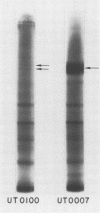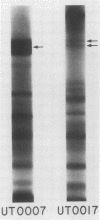Abstract
Tox-+ staphylococcal strains, as opposed to Tox-minus strains, produce epidermal exfoliation within 18 h after direct subcutaneous or intraperitoneal injection into newborn mice. The extracellular product responsible for exfoliation is termed exfoliative toxin (ET). When culture supernatant fluid from the plasmid-cured Tox-minus substrains UT 0100 or UT 0111 or from six naturally occurring phage group 2 Tox-minus strains was concentrated 20-fold and inoculated into newborn mice, ET activity could be detected. The Tox-minus, cured derivatives produced ET at levels which were 32 minus and 64-fold lower than the amounts made by their Tox-+ parent strains. Since these Tox-minus, cured substrains contained no plasmid deoxyribonucleic acid, it was postulated that the product possessing ET activity in strains UT 0100 and UT 0111 was made by chromosomal genes. This product has been isolated and purified from strain UT 0100 and appears as two faint bands after electrophoresis on polyacrylamide gels and corresponds in position to a heavy band of ET isolated from the Tox-+ strain UT 0007.
Full text
PDF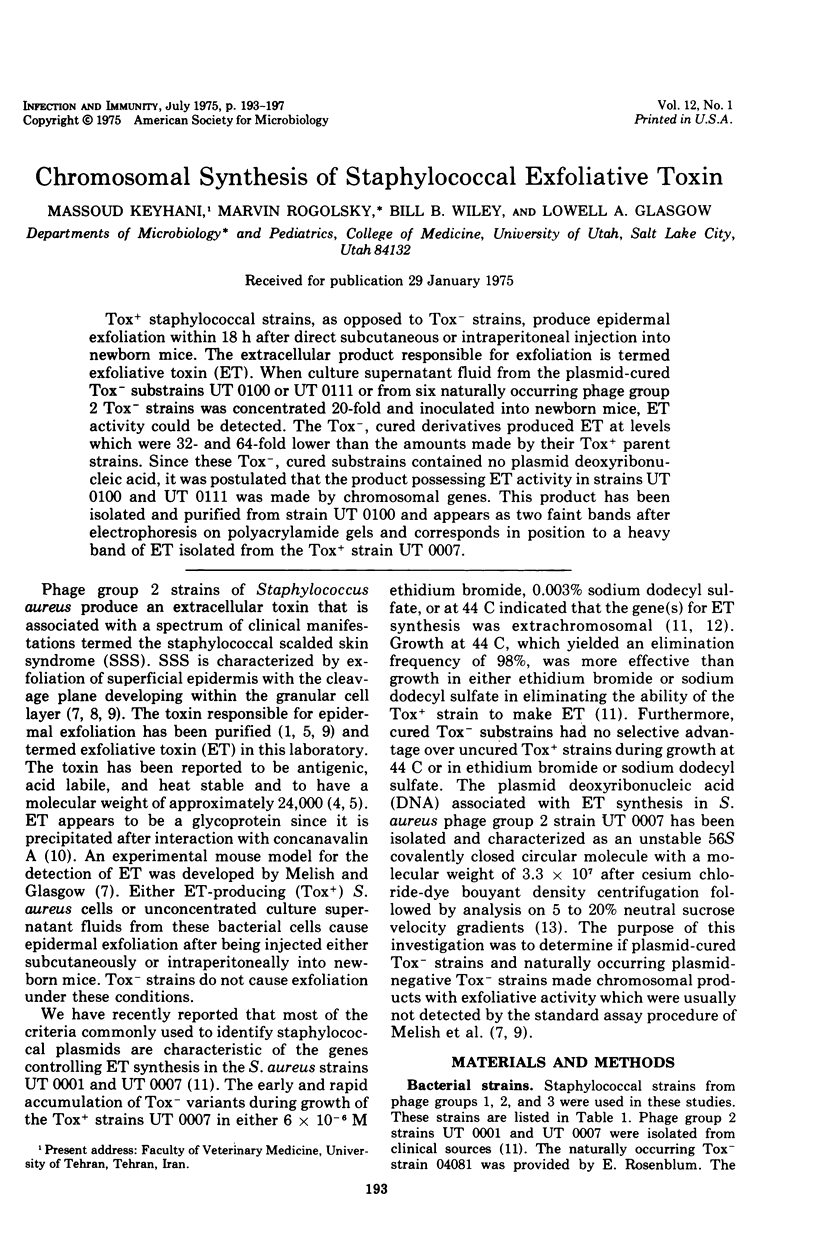
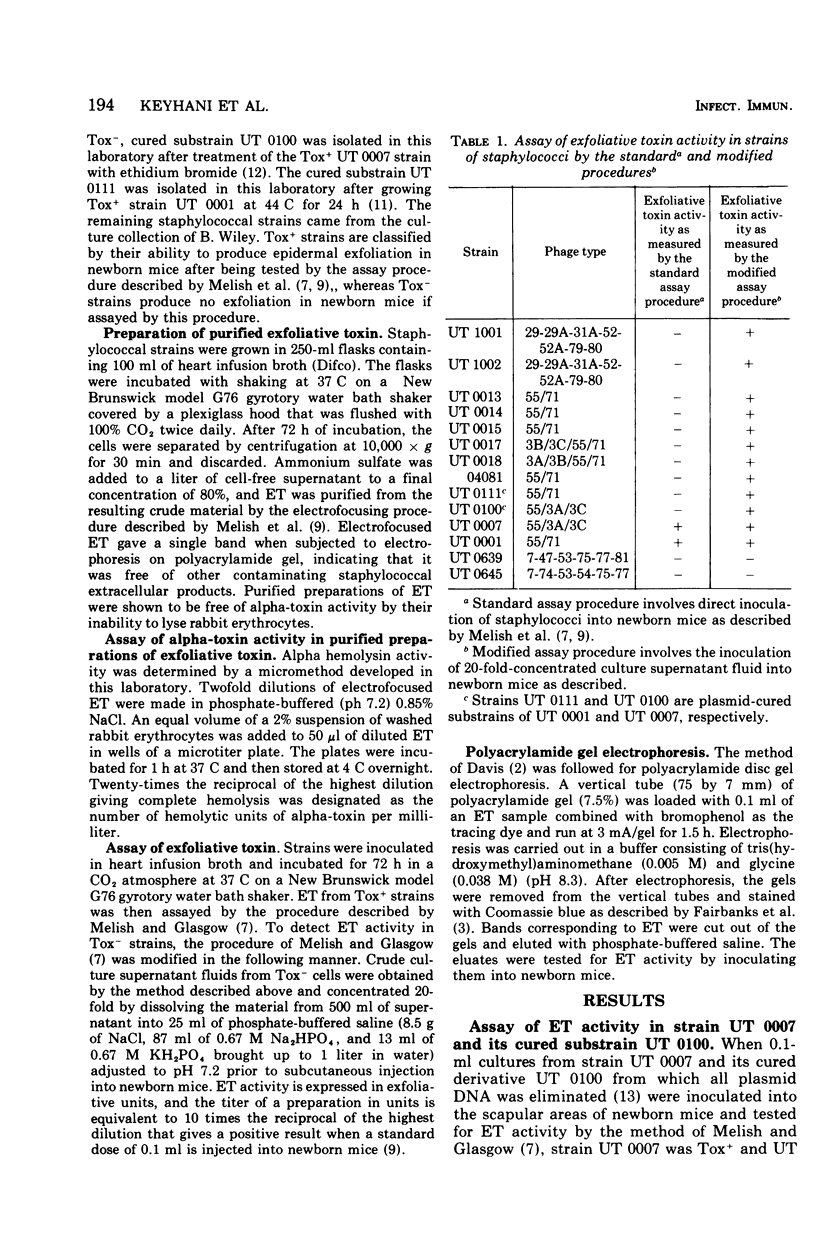
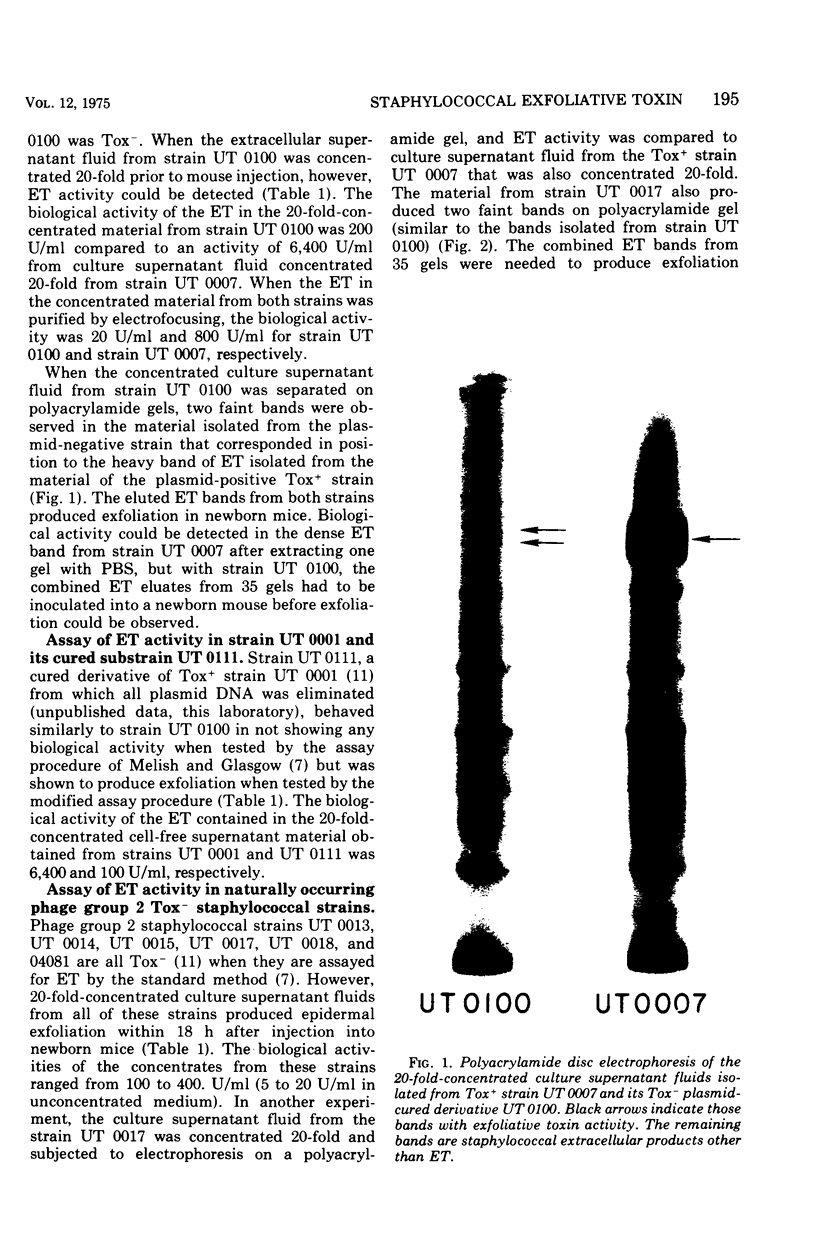
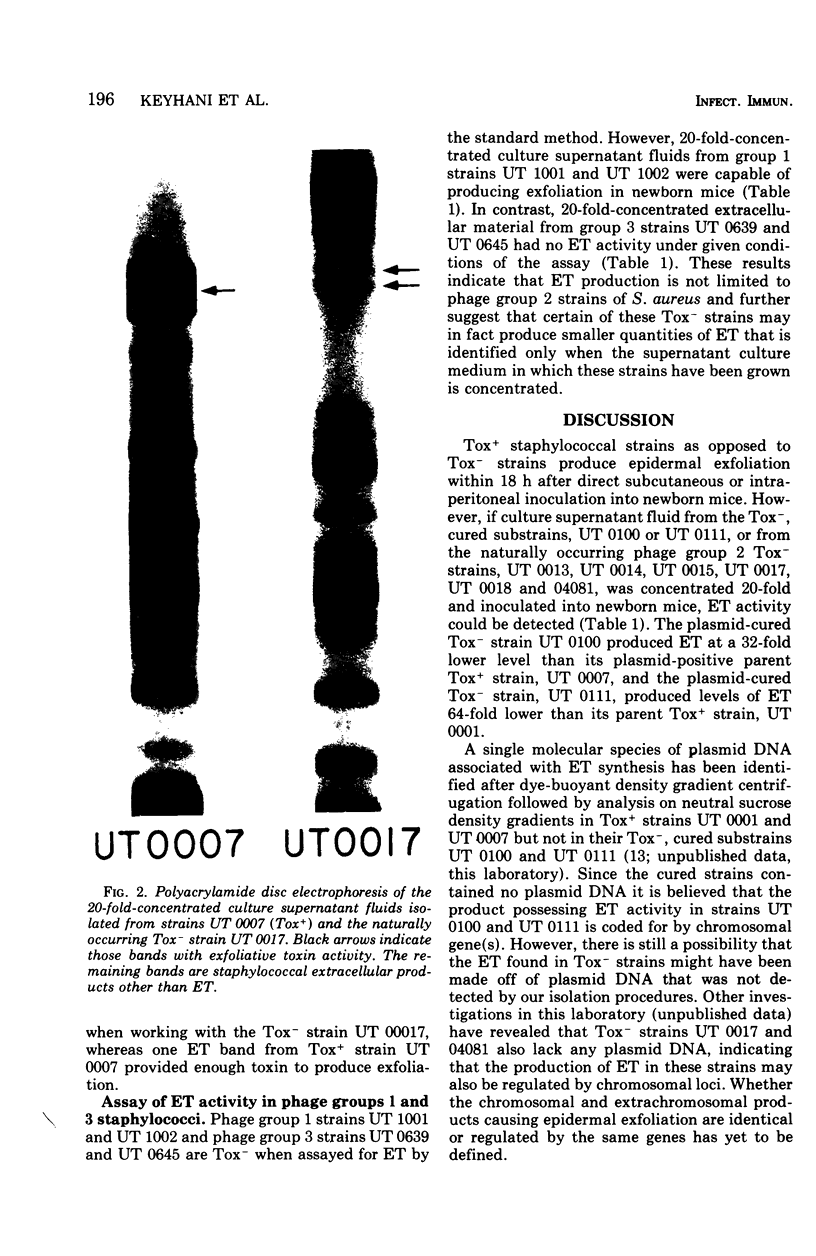
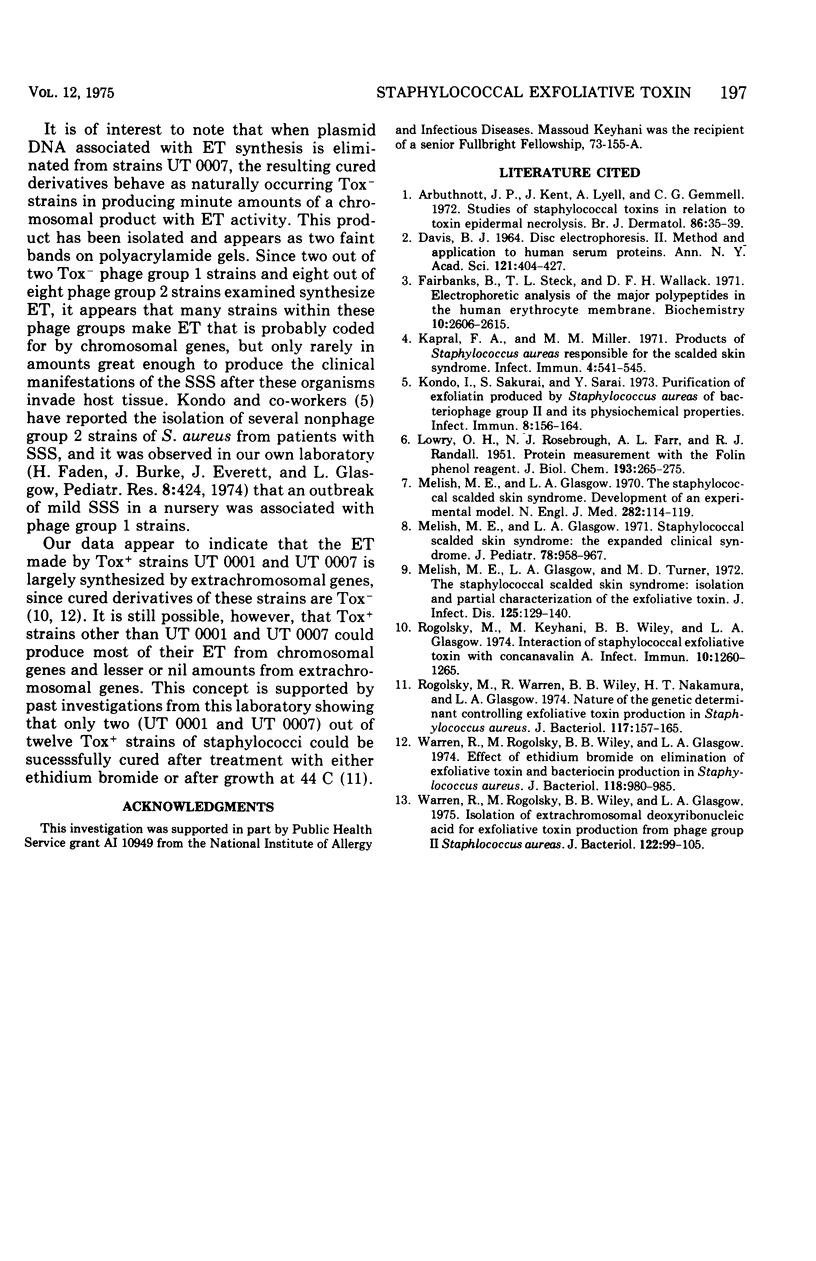
Images in this article
Selected References
These references are in PubMed. This may not be the complete list of references from this article.
- DAVIS B. J. DISC ELECTROPHORESIS. II. METHOD AND APPLICATION TO HUMAN SERUM PROTEINS. Ann N Y Acad Sci. 1964 Dec 28;121:404–427. doi: 10.1111/j.1749-6632.1964.tb14213.x. [DOI] [PubMed] [Google Scholar]
- Fairbanks G., Steck T. L., Wallach D. F. Electrophoretic analysis of the major polypeptides of the human erythrocyte membrane. Biochemistry. 1971 Jun 22;10(13):2606–2617. doi: 10.1021/bi00789a030. [DOI] [PubMed] [Google Scholar]
- Kapral F. A., Miller M. M. Product of Staphylococcus aureus responsible for the scalded-skin syndrome. Infect Immun. 1971 Nov;4(5):541–545. doi: 10.1128/iai.4.5.541-545.1971. [DOI] [PMC free article] [PubMed] [Google Scholar]
- Kondo I., Sakurai S., Sarai Y. Purification of exfoliatin produced by Staphylococcus aureus of bacteriophage group 2 and its physicochemical properties. Infect Immun. 1973 Aug;8(2):156–164. doi: 10.1128/iai.8.2.156-164.1973. [DOI] [PMC free article] [PubMed] [Google Scholar]
- LOWRY O. H., ROSEBROUGH N. J., FARR A. L., RANDALL R. J. Protein measurement with the Folin phenol reagent. J Biol Chem. 1951 Nov;193(1):265–275. [PubMed] [Google Scholar]
- Melish M. E., Glasgow L. A. Staphylococcal scalded skin syndrome: the expanded clinical syndrome. J Pediatr. 1971 Jun;78(6):958–967. doi: 10.1016/s0022-3476(71)80425-0. [DOI] [PubMed] [Google Scholar]
- Melish M. E., Glasgow L. A., Turner M. D. The staphylococcal scalded-skin syndrome: isolation and partial characterization of the exfoliative toxin. J Infect Dis. 1972 Feb;125(2):129–140. doi: 10.1093/infdis/125.2.129. [DOI] [PubMed] [Google Scholar]
- Rogolsky M., Warren R., Wiley B. B., Nakamura H. T., Glasgow L. A. Nature of the genetic determinant controlling exfoliative toxin production in Staphylococcus aureus. J Bacteriol. 1974 Jan;117(1):157–165. doi: 10.1128/jb.117.1.157-165.1974. [DOI] [PMC free article] [PubMed] [Google Scholar]
- Rogolsky M., Wiley B. B., Keyhani M., Glasgow L. A. Interaction of staphylococcal exfoliative toxin with concanavalin A. Infect Immun. 1974 Dec;10(6):1260–1265. doi: 10.1128/iai.10.6.1260-1265.1974. [DOI] [PMC free article] [PubMed] [Google Scholar]
- Warren R., Rogolsky M., Wiley B. B., Glasgow L. A. Effect of ethidium bromide on elimination of exfoliative toxin and bacteriocin production in Staphylococcus aureus. J Bacteriol. 1974 Jun;118(3):980–985. doi: 10.1128/jb.118.3.980-985.1974. [DOI] [PMC free article] [PubMed] [Google Scholar]
- Warren R., Rogolsky M., Wiley B. B., Glasgow L. A. Isolation of extrachromosomal deoxyribonucleic acid for exfoliative toxin production from phage group II Staphylococcus aureus. J Bacteriol. 1975 Apr;122(1):99–105. doi: 10.1128/jb.122.1.99-105.1975. [DOI] [PMC free article] [PubMed] [Google Scholar]



